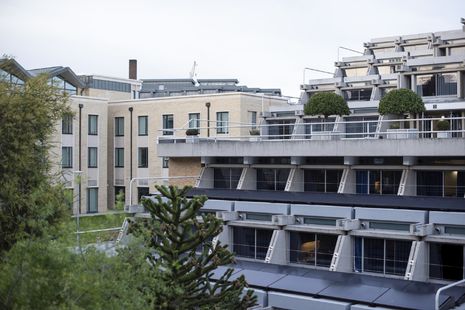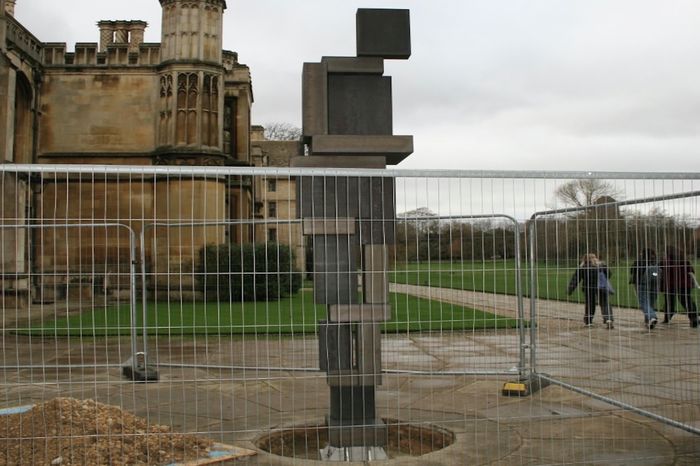Turing and the Typewriter
Although brutalist modern architecture can lack beauty, the new Turing sculpture should be welcomed, argues Emily Kelly

At King’s College, a sculpture memorialising Alan Turing was recently unveiled amid criticism from Historic England and the student community. The sculpture, created by celebrated artist Sir Anthony Gormley, comprises a stack of steel blocks arranged to resemble a person “looking forward” but making “a self-protective gesture” to reflect both Turing’s vision as a computing pioneer and the discrimination he faced as a gay man in the 1950s. Everything about the sculpture is highly deliberate, from its size (designed "to be in effective dialogue with the buildings around it") to its material (“an expression of the industrial and computer age using techniques only made possible through computing”). Unfortunately, there is no avoiding the fact that it is also incredibly ugly.
“Is it a blot on the Cambridge landscape, or a relic of the past which will fascinate future generations?”
As a Christ’s college student, the debate surrounding the sculpture immediately caught my eye because of its similarity to my college’s own resident eyesore: the Typewriter. Built in the 1960s, the Typewriter is a concrete monstrosity which regularly features on “ugliest building” lists online. At seven floors high – with no lifts – it’s also incredibly inconvenient to live in, and the combination of concrete and floor-to-ceiling windows means that it gets unbearably hot in summer. But Blue Crow Media describes it as “fantastic” and features it on their “Modern Cambridge map” as a significant and interesting example of modernist architecture. With its stepped façade and concrete-meets-cruise-ship sparseness, the typewriter is certainly unique. So what are we to make of it? A blot on the Cambridge landscape, or a relic of the past which will fascinate future generations?

This brings us to another important point. Cambridge colleges have always updated their architecture to move with the times, and many of Cambridge’s most incredible buildings would not exist had people been overly attached to the idea of preserving the past untouched. At King’s, the stunning Gibbs building, built in 1723, is incredibly different in style to the adjacent Medieval chapel. Situated next to the Gibbs Building, the Turing sculpture stands testament to the passage of time, a reminder that Cambridge colleges are not just history, but living history, and continue to grow and change with the world around them. It can be easy to forget that modern times will be just as fascinating to people in 300 years as 1723 is to us now.
But all this seems rather like a false dichotomy. The Typewriter is a 1960s block of concrete, built with poor-quality materials and a negative regard for aesthetics. By contrast, the Gibbs building is a resplendent example of Georgian architecture. Sure, putting a modern-style sculpture in the middle of King’s College might be OK if we were still building things as stunning as what we built in the 18th century, but given that modern art and architecture seems to be almost deliberately opposed to the idea of beauty, doesn’t it make sense to preserve what we have?
This is a sentiment I can sympathise with. In my hometown of Exeter, I am the first to bemoan the postwar decision to replace bombed-out buildings with modern monstrosities in the name of “progress". Too often in modern art and architecture, beauty is sidelined in favour of “functionality” (in spite of evidence that beautiful surroundings improve health and wellbeing, making beauty a key component of a building’s success). In the case of the Turing sculpture, the symbolic value of industrial aesthetics seems to have been prioritised over the everyday desire to preserve and observe the beautiful.
“A fitting tribute to a man who deeply deserves to be remembered”
But where is Alan Turing in all this? In a world filled with statues glorifying problematic, slave-owning men, a sculpture commemorating someone who suffered horrific persecution despite making heroic and world-changing contributions is much-needed and inspiring. Historic England complained about the sculpture’s “prominent” location, but to hide it away in a less visible corner of the college would do a disservice to Turing’s memory. Similarly, to build the sculpture (as suggested by the council) in a style more similar to the buildings around it would be to take Turing – a man in large part responsible for the development of the modern world – profoundly out of context. As the College notes in its planning application, the sculpture uses techniques and materials which Turing himself made possible, making it a fitting tribute to a man who deeply deserves to be remembered.
Perhaps the problem isn’t the Turing sculpture, but the wider state of modern art. The Turing sculpture is a long-overdue acknowledgement of a man who was mistreated during his lifetime, and has been built just as it should be – in the style of the era which Turing helped shape. But the furore surrounding it ought to give artists pause, to encourage them to step back and consider whether their work is fulfilling all the functions that it should be. Modern art is often forward-thinking and deeply symbolic, but it has also lost sight of art’s integral function of fulfilling our need for beauty. In another world, perhaps, artists and architects would use modern techniques to create things which were not only interesting but also aesthetically pleasing in new and innovative ways. In that world, the Turing sculpture might look different. I, for one, am looking forward to when it materialises – and to the buildings and sculptures that world will contribute to the Cambridge landscape.
 News / SU reluctantly registers controversial women’s soc18 December 2025
News / SU reluctantly registers controversial women’s soc18 December 2025 Features / Should I stay or should I go? Cambridge students and alumni reflect on how their memories stay with them15 December 2025
Features / Should I stay or should I go? Cambridge students and alumni reflect on how their memories stay with them15 December 2025 News / Dons warn PM about Vet School closure16 December 2025
News / Dons warn PM about Vet School closure16 December 2025 News / Cambridge study finds students learn better with notes than AI13 December 2025
News / Cambridge study finds students learn better with notes than AI13 December 2025 News / Uni registers controversial new women’s society28 November 2025
News / Uni registers controversial new women’s society28 November 2025










